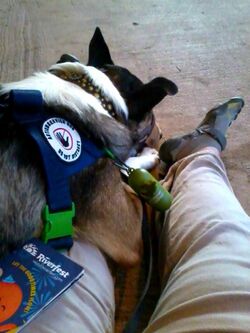Medicine:Autism assistance dog
An autism assistance dog or autism service dog is an assistance dog trained to assist an autistic person manage their disability and live more independently.
History
The first autism assistance dog was trained by Chris Fowler, who founded the first organization worldwide called National Service Dogs in 1996. He placed a dog named Shade with an autistic child in 1997. Autism is a lifelong disability with characteristics that vary from person to person.[1][2] Training for autism assistance dogs is similar to guide dog training.[3] Autism assistance dogs usually cost between $12,000 and $30,000. There is often a long wait list for autism assistant dogs.[4][5]
Anecdotal evidence of the efficacy of autism assistance dogs is greater than the amount of research on the practice.[6] Without objective standards, it can be difficult for parents, caregivers, and educators to make a case for the need for autism assistance dogs.[7]
Function
Autism assistance dogs are trained to perform specific tasks to help their owners live independently and navigate the world. Autism assistant dogs often perform tasks like DPT (Deep Pressure Therapy), back/front block, crowd control, alerting to sounds such as timers or a fire alarm, medication reminders, self-injury interruption, retrieving dropped items and other tasks to help calm anxiety, prevent sensory overload or underwhelm, ensure safety and assist in daily living.
Children
The primary focus of an autism assistance dog for a child is to protect the safety of the children they work with.[3] For example, autism assistance dogs are sometimes trained to prevent children with autism from leaving the house unsupervised.[8] When autism assistance dogs are paired with children, the dog often takes commands from the parents, not the child.[3] Autism assistance dogs also alert parents of dangerous situations regarding the children they work with.[9] Autism assistance dogs can help open the door for children and keep them from becoming overstimulated or understimulated.[10]
Some children with autism have been reported to have an increased sense of independence because of their interactions with the autism assistance dog.[11]
Sometimes a child harness—attached to an autism assistance dog—is worn by the autistic child. There recently has been controversy over this, due to the sudden force put on the dog as well as it preventing the child from escaping distressing situations.[12]
Adults
As with hearing dogs for the deaf, the dogs may be trained to alert their handler to important noises or other things requiring human intervention, such as smoke or a smoke alarm, a crying baby, a telephone ringing, or a knock at the door. For a person with autism, it may not be immediately obvious which of the many external stimuli is the urgent one requiring their immediate attention. A person with autism may have to sort through both major and minor stimuli—the sound of crickets, the smell of the fabric softener on their clothes, a car driving past outside—to determine which of these, if any, needs their attention. They may understand that a smoke alarm is urgent and requires them to exit the building, but it might take more time to realize the alarm is sounding in the first place.
Autism assistance dogs may use a command to "ground" their owners by sitting on their feet, applying pressure when the owner is anxious or overwhelmed such as DPT.[13]
See also
- Guide dog
- Hearing dog
- Medical response dog
- Mobility assistance dog
- Psychiatric service dog
- Seizure dog
- Service animal
- Child harness
References
Citations
- ↑ Pavlides, Merope (2008). Animal-assisted interventions for individuals with autism. London: Jessica Kingsley Publishers. ISBN 9781843108672. OCLC 289360730.
- ↑ Burrows, Adams & Millman 2008, p. 42.
- ↑ 3.0 3.1 3.2 Burrows, Adams & Millman 2008, p. 43.
- ↑ Prewett, Nathan (2017-06-02). "Trussville family raising money for autism service dog for HTHS grad" (in en-US). The Trussville Tribune. http://www.trussvilletribune.com/2017/06/02/trussville-family-raising-money-for-service-dog-for-autistic-son/.
- ↑ "Families seeking autism service dogs face years-long wait lists" (in en-CA). CTVNews. 2017-05-28. http://www.ctvnews.ca/health/families-seeking-autism-service-dogs-face-years-long-wait-lists-1.3433371.
- ↑ Butterly, Percy & Ward 2013, p. 2721.
- ↑ Butterly, Percy & Ward 2013, p. 2724.
- ↑ Simmons, Morgan (10 May 2009). "Autistic Child, Family Getting to Know New Service Dog". Knoxville News-Sentinel. http://search.ebscohost.com/login.aspx?direct=true&db=nfh&AN=2W61576055934&site=ehost-live.
- ↑ Burrows, Adams & Millman 2008, p. 56.
- ↑ McFarland, Laura (12 April 2017). "Powhatan 5-year-old bonds with autism service dog" (in en). Richmond Times-Dispatch. http://www.richmond.com/news/local/central-virginia/powhatan/powhatan-today/powhatan--year-old-bonds-with-autism-service-dog/article_f6a5a4ee-1fa4-11e7-99d2-2f1c28809074.html.
- ↑ O'Haire, ME (March 2013). "Review of current evidence and future directions in animal-assisted intervention for children with autism". OA Autism 10 (1): 1–5. https://www.vet.purdue.edu/chab/ohaire/files/documents/OAautism_2013_OHaire.pdf. Retrieved 2017-10-09.
- ↑ "Common Autism Service Dog Tasks". 13 April 2019. https://anythingpawsable.com/common-autism-service-dog-tasks/.
- ↑ Flores, Ben (2017-03-17). "In Focus, episode 1: Service dog helps woman navigate life with autism | Cronkite News" (in en-US). Cronkite News - Arizona PBS. https://cronkitenews.azpbs.org/2017/03/17/in-focus-episode-1-autism-service-dog/.
Sources
- Burrows, Kristen E.; Adams, Cindy L.; Millman, Suzanne T. (2008). "Factors Affecting Behavior and Welfare of Service Dogs for Children With Autism Spectrum Disorder". Journal of Applied Animal Welfare Science 11 (1): 42–62. doi:10.1080/10888700701555550. PMID 18444026. https://about.illinoisstate.edu/vfdouga/Documents/331/PDF/fall%202016/factors%20afffecting%20behavior%20and%20welfare%20of%20service%20dogs%20(1).pdf.
- Butterly, Felicity; Percy, Carol; Ward, Gillian (November 2013). "Brief Report: Do Service Dog Providers Placing Dogs with Children with Developmental Disabilities Use Outcome Measure and, If So, What Are They?". Journal of Autism and Developmental Disorders 43 (11): 2720–2725. doi:10.1007/s10803-013-1803-1. PMID 23479076.
 |


